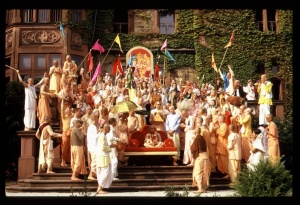CC Madhya 23.52: Difference between revisions
No edit summary |
(Vanibot #0054 edit - transform synonyms into clickable links, which search similar occurrences) |
||
| Line 17: | Line 17: | ||
<div class="synonyms"> | <div class="synonyms"> | ||
''nirveda-harṣa-ādi'' | ''[//vanipedia.org/wiki/Special:VaniSearch?s=nirveda&tab=syno_o&ds=1 nirveda]-[//vanipedia.org/wiki/Special:VaniSearch?s=harṣa&tab=syno_o&ds=1 harṣa]-[//vanipedia.org/wiki/Special:VaniSearch?s=ādi&tab=syno_o&ds=1 ādi]'' — complete despondency, jubilation and so on; ''[//vanipedia.org/wiki/Special:VaniSearch?s=tetriśa&tab=syno_o&ds=1 tetriśa]'' — thirty-three; ''[//vanipedia.org/wiki/Special:VaniSearch?s=vyabhicārī&tab=syno_o&ds=1 vyabhicārī]'' — transitory elements; ''[//vanipedia.org/wiki/Special:VaniSearch?s=saba&tab=syno_o&ds=1 saba] [//vanipedia.org/wiki/Special:VaniSearch?s=mili&tab=syno_o&ds=1 mili] '' — all meeting together; ''[//vanipedia.org/wiki/Special:VaniSearch?s=rasa&tab=syno_o&ds=1 rasa]'' — the mellow; ''[//vanipedia.org/wiki/Special:VaniSearch?s=haya&tab=syno_o&ds=1 haya]'' — becomes; ''[//vanipedia.org/wiki/Special:VaniSearch?s=camatkāra&tab=syno_o&ds=1 camatkāra]-[//vanipedia.org/wiki/Special:VaniSearch?s=kārī&tab=syno_o&ds=1 kārī]'' — a cause of wonder. | ||
</div> | </div> | ||
Latest revision as of 22:59, 19 February 2024

A.C. Bhaktivedanta Swami Prabhupada
TEXT 52
- nirveda-harṣādi—tetriśa ‘vyabhicārī’
- saba mili’ ‘rasa’ haya camatkāra-kārī
SYNONYMS
nirveda-harṣa-ādi — complete despondency, jubilation and so on; tetriśa — thirty-three; vyabhicārī — transitory elements; saba mili — all meeting together; rasa — the mellow; haya — becomes; camatkāra-kārī — a cause of wonder.
TRANSLATION
"There are other ingredients, beginning with complete despondency and jubilation. Altogether there are thirty-three varieties, and when these combine, the mellow becomes very wonderful.
PURPORT
Nirveda, harṣa and other symptoms are explained in Madhya-līlā 14.167. The transitory elements (vyabhicārī) are described in the Bhakti-rasāmṛta-sindhu as follows:
- athocyante trayas triṁśad-bhāvā ye vyabhicāriṇaḥ
- viśeṣeṇābhimukhyena caranti sthāyinaṁ prati
- vāg-aṅga-sattva-sūcyā ye jñeyās te vyabhicāriṇaḥ
- sañcārayanti bhāvasya gatiṁ sañcāriṇo’pi te
- unmajjanti nimajjanti stāyiny amṛta-vāridhau
- ūrmi-vad vardhayanty enaṁ yānti tad-rūpatāṁ ca te
"There are thirty-three transitory elements, known as vyabhicārī ecstatic emotions. They especially wander about the permanent sentiments as assistants. They are to be known by words, by different symptoms seen in the limbs and in other parts of the body, and by the peculiar conditions of the heart. Because they set in motion the progress of the permanent sentiments, they are specifically called sañcārī, or impelling principles. These impelling principles rise up and fall back in the permanent sentiments of ecstatic love like waves in an ocean of ecstasy. Consequently they are called vyabhicārī."